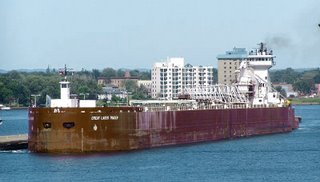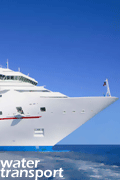Thursday, July 2, 2009
The Environmental Protection Agency (EPA) on 1st July 2009 proposed new policy on smokestack pollution from ships, challenging lower-sulfur fuel and more proficient engines from the maritime industry.
The regulations, which could go into action in 2012, expected to reduce sulfur in marine fuel by 96% and cut particulate emissions from smokestacks by 85% and smog-causing nitrogen oxide by 80%. The water transportation is usually considered to have less environmental impact than land transportation since less fuel is required to carry the same freight by water than on ground, larger passenger and freight ships are considered as a major resource of global air pollution. That's because they burn dirtier, high-sulfur fuel. Trucks & other road-way transport vehicles would be burning a much cleaner diesel fuel.
The water transportation is usually considered to have less environmental impact than land transportation since less fuel is required to carry the same freight by water than on ground, larger passenger and freight ships are considered as a major resource of global air pollution. That's because they burn dirtier, high-sulfur fuel. Trucks & other road-way transport vehicles would be burning a much cleaner diesel fuel.
 The water transportation is usually considered to have less environmental impact than land transportation since less fuel is required to carry the same freight by water than on ground, larger passenger and freight ships are considered as a major resource of global air pollution. That's because they burn dirtier, high-sulfur fuel. Trucks & other road-way transport vehicles would be burning a much cleaner diesel fuel.
The water transportation is usually considered to have less environmental impact than land transportation since less fuel is required to carry the same freight by water than on ground, larger passenger and freight ships are considered as a major resource of global air pollution. That's because they burn dirtier, high-sulfur fuel. Trucks & other road-way transport vehicles would be burning a much cleaner diesel fuel.The regulation would stop the sales and production of the marine fuel oil above 1,000 parts/million sulfur for use on all U.S. water transport. This would reduce sulfur content for about 1.5% of fuel now to about 0.1%, which could go into effect in 2012.
While the primary objective of this new regulation is oceangoing freighters, the plan also affects Great Lakes traffic.
Most big freighters now burn No. 6 oil, also called bunker fuel, which is heavier and dirtier than diesel fuel.
This new engine plan would apply only to the U.S. ships. But Obama's administration and environmental groups expected to extend this rule to all foreign ships as well. They want the International Maritime Organization to support a 200-mile clean-air zone around the Canada and U.S., applying to all ships.
Labels: Environmental Protection Agency, G, Water Transportation
posted by transport blogs
@ 10:13 PM
permanent link | Post a Comment
| 0
comments
![]()









